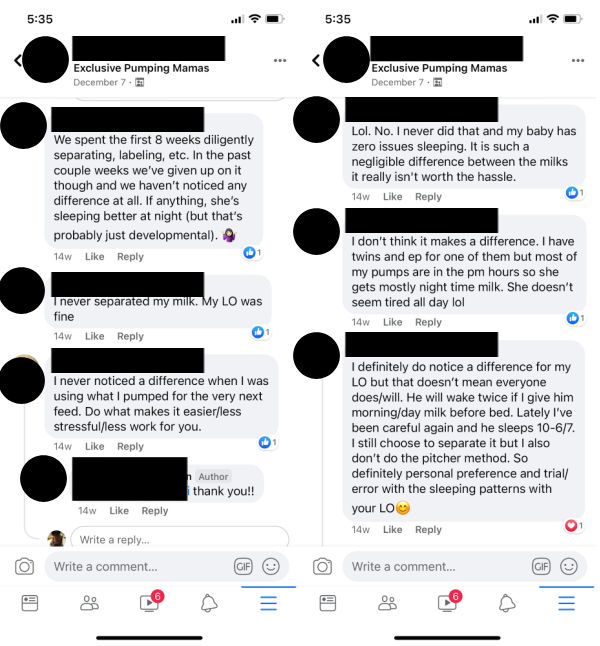You might have heard that day milk is different from night milk, and that you should feed your baby milk that was pumped at the same time of day as it’s being fed. Here’s what you need to know about how breast milk changes over the course of a day.

How breast milk changes during the day
What exactly is in your breast milk will vary over the course of a 24-hour time period. Here is some of what we know about these changes.
1. Breast milk follows a circadian rhythm
A circadian rhythm is an internal process that regulates the sleep-wake cycle, repeating every 24 hours.
One systematic review that looked at variations in human milk found the following:
Significant circadian variation is found in tryptophan, fats, triacylglycerol, cholesterol, iron, melatonin, cortisol, and cortisone.
Therefore, the composition of breast milk does change across a 24 hour period.
2. Melatonin levels are highest at night
Another study took samples of breast milk at four different points throughout the day (3am, 9am, 3pm, and 9pm).
Melatonin levels displayed the same circadian rhythm shown in the previously-mentioned study, with the high point of melatonin concentration occurring at 3am.
3. Melatonin levels in breast milk do not change during storage
If you pump your milk and store it, the amount of melatonin in the milk does not appear to change or degrade.
One study collected daytime milk and nocturnal milk from 13 participants, whose milk was immediately frozen.
The frozen samples were defrosted and tested immediately and then every 4 hours for 24 hours. There was no statistical difference in the levels of melatonin in the milk over the 24 hour time period.
So are you supposed to separate day milk and night milk?
So what does all this actually mean to you?
Some articles have suggested that you should keep milk that you pump during the day separate from the milk that you pump at night, and feed it at the “correct” time of day based on when it was pumped.
Here is an example from Today’s Parent:
If chronosignals in milk do indeed help to calibrate infant circadian biology, then infants who drink “mistimed” milk may struggle more with sleep, digestion and development.
There’s a fairly easy fix, of course. Mothers can label their milk with the time it was pumped and coordinate infant feedings to offer morning milk in the morning, afternoon milk in the afternoon and night milk at night.
Is this really an “easy fix”?
For some breastfeeding parents, it probably is.
If you primarily nurse and only pump at work, for example, you could label your bottles in the order that you pump them and ask your childcare provider to serve them in the same order.
Or if you’re primarily pumping for date nights out, you could try do most of your pumping after baby has gone to bed.
But for other parents – exclusive pumpers, for example – it’s not so easy.
Exclusive pumpers are managing quite a bit of breast milk – some pump more than 30 oz every single day. That’s a lot of milk to try to store and coordinate for feedings.
Cost vs benefits of segregating milk
When deciding whether or not you want to label your milk and feed it at the same time of day that it was pumped, it makes sense to weigh the costs versus the benefits of doing so.
Potential benefits
First, let’s consider the benefits.
We know that breast milk changes over the course of the day, but we don’t know what effect that has on the baby receiving the milk. The suggestion above that infants may “struggle” with mistimed milk is just that – a suggestion, one that seems reasonable but is not backed in research.
The timing of the milk that a baby receives could make a big difference to how baby sleeps and adjusts to a sleep/wake cycle, or it could make some difference, or it could make a negligible difference. It’s likely that – as with many things – the effect varies from baby to baby.
We also know that formula-fed babies have no variation in the amount of melatonin (or the other substances mentioned above) present in the milk that they drink. (There is no “AM” formula and “PM” formula, for example.)
And we know that donor milk banks do not segregate the milk based on time that it was pumped (in fact, multiple donors’ milk is usually mixed all together during this process).
So there may be a benefit, but we don’t know for sure, and we don’t know the extent.
Potential costs
Now, let’s think about the costs.
Again, for some parents this may be pretty straightforward and easy to do (as an example, the parent who decides to pump for date nights after baby has gone to bed).
For others, it might not be so easy. Exclusive pumping can feel like a full-time job, on top of caring for your baby and everything else you need to do. Adding one more thing, even if it doesn’t seem like a big thing – in this case, managing the timing of pumped milk – on top of everything else can feel like a lot.
It’s also easy to get decision fatigue and feel stress that you’re not doing everything right. For example, say your baby wakes up hungry at 2am and you have 11pm and 4am milk in the fridge. Some parents will just shrug and pick one; others will fret about this, and it can become a little thing that adds to the general overwhelm and sense of “you’re doing it wrong.”
So what should you do?
If this is something that you’re concerned about, my suggestion is to test this out with your baby and see how it goes. Give morning milk in the morning and night milk at night for a few days, and then switch for a few days.
While you’re doing this, pay attention to your baby. Is she having trouble sleeping? Is she unhappy? Or are things pretty much the same?
This should give you an idea of the benefits.
For reference, here is a Facebook group thread about testing this out and what people found:

Then consider your situation and what you would need to do to correctly time the milk that your baby eats with when it was pumped. How hard will this be for you? Will it be no big deal, or will it be one more thing that will stress you out?
Hopefully, this will give you an idea of whether or not it’s worth it for you and your baby.
Feeding day milk/night milk at the same time it was pumped
If you do want to feed milk at the same approximate time that it was pumped, there are a few ways you can do this.
Some people label their milk with the time pumped, and then do their best to match up AM milk to AM feeds and PM milk to PM feeds.
Others do a modified version of the pitcher method, but with an AM pitcher for morning milk and a PM pitcher for night milk.
Do you separate day milk and night milk? Tell us how you do it in the comments!
References- Hahn-Holbrook, Jennifer. “Giving your baby morning breastmilk at bedtime might be ruining his sleep.” Today’s Parent. https://www.todaysparent.com/baby/baby-sleep/giving-your-baby-morning-breastmilk-at-bedtime-might-be-ruining-his-sleep/
- Italianer MF, Naninck EFG, Roelants JA, van der Horst GTJ, Reiss IKM, Goudoever JBV, Joosten KFM, Chaves I, Vermeulen MJ. Circadian Variation in Human Milk Composition, a Systematic Review. Nutrients. 2020 Aug 4;12(8):2328. doi: 10.3390/nu12082328. PMID: 32759654; PMCID: PMC7468880. https://pubmed.ncbi.nlm.nih.gov/32759654/
- PMolad M, Ashkenazi L, Gover A, Lavie-Nevo K, Zaltsberg-Barak T, Shaked-Mishan P, Soloveichik M, Kessel I, Rotschild A, Etzioni T. Melatonin Stability in Human Milk. Breastfeed Med. 2019 Nov;14(9):680-682. doi: 10.1089/bfm.2019.0088. Epub 2019 Aug 5. PMID: 31381362. https://pubmed.ncbi.nlm.nih.gov/31381362/
- Qin Y, Shi W, Zhuang J, Liu Y, Tang L, Bu J, Sun J, Bei F. Variations in melatonin levels in preterm and term human breast milk during the first month after delivery. Sci Rep. 2019 Nov 29;9(1):17984. doi: 10.1038/s41598-019-54530-2. PMID: 31784629; PMCID: PMC6884443. https://pubmed.ncbi.nlm.nih.gov/31784629/












